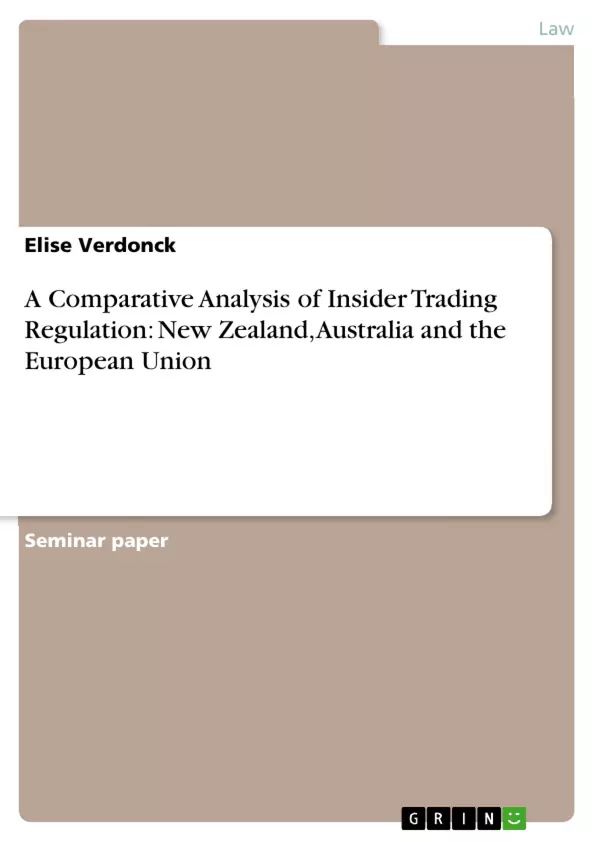Since the financial crisis in 2008 there is no doubt about the fact that the evolving financial markets are essential for economic growth, employment and prosperity. Those markets serve as financing means for the business world and consumers benefit from the availability of a wide range of financial products and the additional advantages that those markets entail (higher pensions and lower mortgage costs). However, if those financial markets want to continue to contribute both to economy and society, the promotion of a good, integer and transparent functioning of those markets is essential. The proper functioning of the financial markets is largely dependent on the confidence of investors in those markets. The fact that investors ‘must be placed on an equal footing’ is the underlying principle on which this confidence is based. Market participants must be assured to always have access to a minimum set of information before making their investment decisions. In this context, transparency plays an important role. The price of a financial instrument is always the result of the available financial information. And to have proper price formation, it is essential that all the stakeholders have equal access to the relevant information as much as possible. A lot of regulations have already been introduced in this area. Yet, the effectiveness of those regulations can be questioned. For example, directors can make use of certain non-public information to trade in securities. They abuse their superior knowledge and consequently other investors regard this as unfair trading. Due to those unfair practices, other potential investors will turn their back to the financial markets. Insider trading is likely to undermine the investors’ confidence in the market and may jeopardise the proper functioning of the market. Therefore insider trading should be prohibited. But in most cases, law enforcement authorities face difficulties in proving the offenses. Hence, insider trading is a social evil and remains difficult to combat. This research essay will compare the current legislation on insider trading in New Zealand, Australia and the EU.This research essay will compare the current legislation on insider trading in New Zealand, Australia and the EU. In the end, it will be clear that the fundamental differences between the three jurisdictions remain off.
Inhaltsverzeichnis (Table of Contents)
- Introduction
- Why Regulate Insider Trading?
- Introduction
- The Classic View: Non-Regulation of Insider Trading
- The Rationales for Insider Trading Regulation
- The fiduciary duty rationale
- The misappropriation rationale
- Market fairness
- Market efficiency
- Insider Trading in New Zealand and Australia
- Backdrop of the Current Statutory Provisions in New Zealand
- The pre Securities Markets Act era
- The Securities Amendment Act of 1988
- Policy shift of 2006
- Australia
- Conclusion
- Key Definitions: Insider & Inside Information
- Reasonable person
- Material effect on the price of listed securities
- Generally available
- Conclusion
- Prohibited Actions
- Criminal and Civil Liability
- Sanctions
- Exceptions
- Provisions Applicable on Private Companies
- Challenges in the Current Legal Framework
- Insider Trading in the European Union
- Backdrop of the Current Statutory Provisions
- The Current Statutory Provisions
- What is an insider?
- What is inside information?
- Prohibited actions
- Liability
- Provisions applicable on private companies
- Comparison with New Zealand and Australia
- Challenges in the current legal framework
- Conclusion
Zielsetzung und Themenschwerpunkte (Objectives and Key Themes)
This essay aims to compare the current legislation on insider trading in New Zealand, Australia, and the European Union. It explores the fundamental differences and similarities between the three jurisdictions and analyzes their respective legal frameworks. The main objective is to demonstrate that while these systems share a common foundation in market fairness and efficiency, there are subtle disparities in their definitions, enforcement mechanisms, and sanctions.
- The evolution of insider trading regulations across different jurisdictions
- The rationale behind regulating insider trading, including fiduciary duty, misappropriation, market fairness, and market efficiency
- Key definitions of "insider" and "inside information" in each jurisdiction
- Prohibited actions related to insider trading, such as trading, tipping, and procuring
- Criminal and civil liability for insider trading offenses
Zusammenfassung der Kapitel (Chapter Summaries)
The essay begins by examining the rationale for regulating insider trading, exploring both the classic view advocating non-regulation and the arguments in favor of prohibition. It then delves into the specific legal frameworks of New Zealand and Australia, outlining their historical development, key definitions, prohibited actions, and enforcement mechanisms. The essay highlights the significant shift in New Zealand's approach from a fiduciary rationale to a market-based approach, mirroring the Australian model. The chapter concludes by comparing the two systems and identifying their strengths and weaknesses.
The fourth chapter focuses on insider trading regulation within the European Union, tracing its evolution from the first harmonization efforts to the introduction of the Market Abuse Directive (MAD). It delves into the comprehensive definition of "insider" and "inside information" under MAD, highlighting the distinction between primary and secondary insiders and their respective liability requirements. The chapter also examines the prohibited actions, sanctions, and exceptions under MAD, concluding with a comparative analysis of the EU system with those of New Zealand and Australia.
Schlüsselwörter (Keywords)
This preview covers insider trading regulation, market efficiency, market fairness, fiduciary duty, misappropriation, insider, inside information, trading, tipping, procuring, sanctions, enforcement, New Zealand, Australia, European Union, Market Abuse Directive (MAD), and regulatory convergence.
- Quote paper
- Elise Verdonck (Author), 2014, A Comparative Analysis of Insider Trading Regulation: New Zealand, Australia and the European Union, Munich, GRIN Verlag, https://www.grin.com/document/284137



